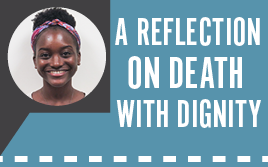Toni-Ann Hall, Staff Writer
Brittany Maynard was a newly married 29-year-old who was diagnosed with brain cancer on News Years’ Day after months of suffering from incapacitating headaches. According to her article on CNN.com, she learned in April 2014 that she had approximately six months to live. Maynard had the option of having a prescribed full brain radiation. Maynard and her family later decided against that measure after coming to the conclusion that there that the decrease in quality of life would not be worth it, because this illness remains incurable.
“I did not want this nightmare scenario for my family, so I started researching death with dignity,” Maynard said in the article.
This was where the news headlines all began. Oregon’s Death with Dignity Act was legislated in 1997. It is often unfavorably described as “assisted suicide.” Public Health records from oregon.gov state that this act “allow[s] terminally ill adult Oregonians to obtain and use prescriptions from their physicians for self-administered, lethal doses of medications.” According to these records, 1,173 people have had these prescriptions written and 752 patients died as a result of the decision to ingest the medication. There are currently three states with a Death with Dignity laws: Washington, Vermont and Oregon.
As a result of the near certainty of the increase in seizures, “morphine-resistant” pain and the significant change and decline of Maynard’s personality, motor skills, and overall well-being, she chose to die “with dignity”.
She moved from California to Oregon to pass away on her terms as she intended. Maynard died on Saturday, Nov. 1.
Soon after the news of her death became public, someone asked me, “Would you do it?” I wish I could answer that question straightforwardly and without second guessing myself, but quite frankly, I don’t know. I’m not in that position. The most I can do is imagine what it must feel like to know that although death is a certainty, it will be a painful and rapidly progressing process.
Many oppose this act, and think that individuals who choose that route are selfishly ridding the world of themselves – similar to the way that suicide is often perceived. Some believe that it means that those individuals lack faith and will to fight. I have yet to figure out how I feel about this situation, other than being at peace with the fact that those individuals are at peace. It’s a decision they knowingly make. Sometimes families are so loving that they don’t want to let the ones closest to them pass on. This is the reason why some patients are on life-support for long periods of time. It’s the miraculous “maybe” that becomes troubling.
Maynard was young and excited about life, like many of us are. Of course she didn’t expect that diagnosis to happen on the turn of a new year. Who would? Everyone has a different threshold for pain, and each family handles situations according to their personal moral compasses. Maynard and her family came to the consensus that choosing her “poison” – so to speak – would be more beneficial that her living a life of suffering.
Getting used to living a life with people, and then the chance of having to laugh, argue, feel pain, and learn lessons and then experience in their absence can be a troublesome realization. So simply asking a question of “Do you think that’s right?” or “What would you do?” does not take into consideration the multiple facets that a decision like this is dependent on.
It’s okay to be unsure of what seems to be yielding of a direct, unwavering answer. Ponder and figure it out on your own time. In the meanwhile, play in the rain, go on swings, build snow angels, and finish checking off items on your bucket list. Brittany Maynard did. The things that unexpectedly occur are often the ones that seem to have the most profound effects in our lives.

